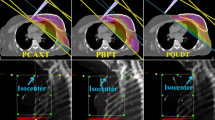Background:
A variety of solutions are used to match tangential fields and opposed lymph node fields in irradiation of nodal positive breast cancer. The choice is depending on the technical equipment which is available and the clinical situation. The CT simulation of a non-monoisocentric technique was evaluated in terms of accuracy and reproducibility.
Patients, Material and Methods: The field match parameters were adjusted virtually at CT simulation and were compared with parameters derived mathematically. The coordinate transfer from the CT simulator to the conventional simulator was analyzed in 25 consecutive patients.
Results: The angles adjusted virtually for a geometrically exact coplanar field match corresponded with the angles calculated for each set-up. The mean isocenter displacement was 5.7 mm and the total uncertainty of the coordinate transfer was 6.7 mm (1 SD). Limitations in the patient set-up became obvious because of the steep arm abduction necessary to fit the 70 cm CT gantry aperture. Required modifications of the arm position and coordinate transfer errors led to a significant shift of the marked matchline of > 1.0 cm in eight of 25 patients (32%).
Conclusion: The virtual CT simulation allows a precise and graphic definition of the field match parameters. However, modifications of the virtual set-up basically due to technical limitations were required in a total of 32% of cases, so that a hybrid technique was adapted at present that combines virtual adjustement of the ideal field alignment parameters with conventional simulation.
Hintergrund:
Für den Feldanschluss zwischen Brusttangenten und ventrodorsal opponierenen Lymphknotenfeldern bei der Bestrahlung des nodal positiven Mammakarzinoms sind verschiedene Methoden in Gebrauch, wobei für die Auswahl technische und klinische Gegebenheiten maßgeblich sind. Die CT-Simulation einer nicht monoisozentrischen Technik wird in dieser Untersuchung hinsichtlich Genauigkeit und Reproduzierbarkeit geprüft.
Patienten, Material und Methode: Feldanschlussparameter wurden mit virtueller Simulation erstellt und mit errechneten Werten verglichen. Der Koordinatentransfer vom CT-Simulator zum konventionellen Simulator wurde bei 25 aufeinanderfolgenden Patienten analysiert.
Ergebnisse: Virtuell eingestellte und berechnete Winkel stimmten exakt überein. Die totale Unsicherheit des Koordinatentransfers war 6,7 mm (1 SD) und die mittlere Isozentrumsabweichung der Tangenten betrug 5,7 mm. Einschränkungen der möglichen Patientenlagerung waren auf den beschränkten CT-Gantry-Durchmesser von 70 cm zurückzuführen, die nur eine steile Armhaltung ermöglichte. Notwendige Änderungen der Armposition und Fehler im Koordinatentransfer machten eine signifikante Verschiebung der Anschlusslinie über 1,0 cm bei acht Patientinnen (32%) erforderlich.
Schlussfolgerung: Die virtuelle CT-Simulation ermöglicht eine genaue und anschauliche Definition der Feldanschlussparameter. Modifikationen dieser Parameter waren jedoch bei acht von 25 (32%) Patientinnen im Wesentlichen aufgrund von gerätetechnischen Einschränkungen erforderlich, sodass derzeit eine “Hybridtechnik” durchgeführt wird, welche die virtuelle Erstellung der Parameter mit der konventionellen Simulation verbindet.
Similar content being viewed by others
Author information
Authors and Affiliations
Additional information
Received: May 15, 2001; accepted: August 6, 2001
Rights and permissions
About this article
Cite this article
Horst, E., Schuck, A., Moustakis, C. et al. CT Simulation in Nodal Positive Breast Cancer. Strahlenther Onkol 177, 511–516 (2001). https://doi.org/10.1007/PL00002361
Issue Date:
DOI: https://doi.org/10.1007/PL00002361




